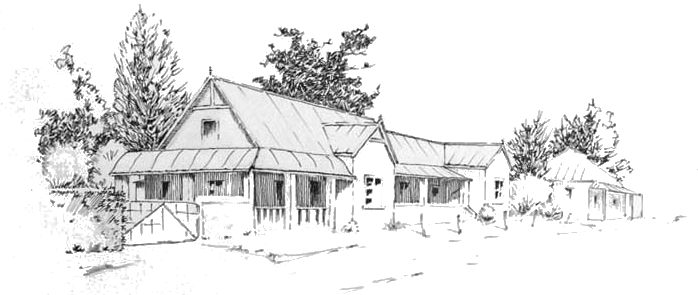OBSERVATIONS FROM A STERKIES VIRGIN by Laurence Davies with pictures by Dave Weaver, Jay Smit and Alan Hobson
Over the years I have missed out on a number of invitations to fish for yellowfish at Sterkfontein Dam, so when I heard Jay mention that Peter Brigg had organised a trip to Sterkfontein and that there was space available, I blurted out that I would love to join the group, as I had never been before. Peter declined as he would be away on the following weekend. The next day I sent a sms to Jay, reminding him that I was available. His response was, ‘Great, be at my place at 5h30 on Friday morning and we will pick up Steve Brooks on the way.’
On the Monday night, at the Durban Fly Tyers meeting, I was cornered by Steve Brookswho gave me some much needed lowdown on what to expect at Sterkfontein and what flies to take along. We would be staying in Harrismith with Dave Weaver, our guide for the weekend. Dave would be providing food and drink, so other than a couple of bottles of wine, or beer, there was no need to lug along a whole bunch of groceries – what a pleasure.
I had good intentions to tie up a bunch of the ‘The Good Doctor’s Beetle’, but it all fell apart in the end as I only managed two beetles. Still sitting in my vice, as I write this, is a hook all ready to be dressed in copper coloured foam – a fly never finished.
I was phoned by Steve on Thursday to say that there was a change in plans. I must get to Jay’s house at 4h30 and then to his house about 5. We would be heading straight to the dam where Dave would be waiting for us.
Thursday night I had everything packed in the car except for my clothes and toiletries. I was planning to get an early night, the alarm being set for 3h45, giving me enough time to shave, brush my teeth, load my clothes and set off. But it was not to be. Firstly, I got to bed later than planned and my wife and I both jumped up when the cell phone beeped at 2 am, thinking that it was my alarm. But it was an sms from the bank – at 2 am for goodness sake. The damage had been done. No matter how much I tried, that was the end of any meaningful sleep.
I drove into Jay’s yard at 4h30 on the dot, and we arrived at Steve’s at 5 to find Linda up and about, seeing Steve off. Jay and I unpacked my car and loaded everything into Steve’s and off we headed for Sterkfontein Dam. It would appear that we all had a bad night’s sleep, as both Steve and Jay had been checking the clock every hour or so, until their alarms eventually went off. So there we were, three sleep deprived, but excited gents heading for the Free State. We had been so eager to set off that I had not closed my car door before we left. Fortunately Linda had noticed that it was open and closed it, which saved a flat battery.
Click in image to enlarge

Sterkfontein Dam Picture by Alan Hobson
We arrived at the dam at 8h15 to find Dave busy at the slipway, having offloaded the boat. After hearty greetings, tackle assembled and loaded onto the boat, we sped off for the far side of the dam. So began my introduction to fly fishing for yellowfish at the great Sterkfontein Dam, or Sterkies, as it has become popularly known. And what an introduction it was for me! Here I was, with many years’ experience, having fished for trout in stillwaters and fished in the salt, and I would have to make some major adjustments when fishing for yellows. Not easy, as it would prove to be.
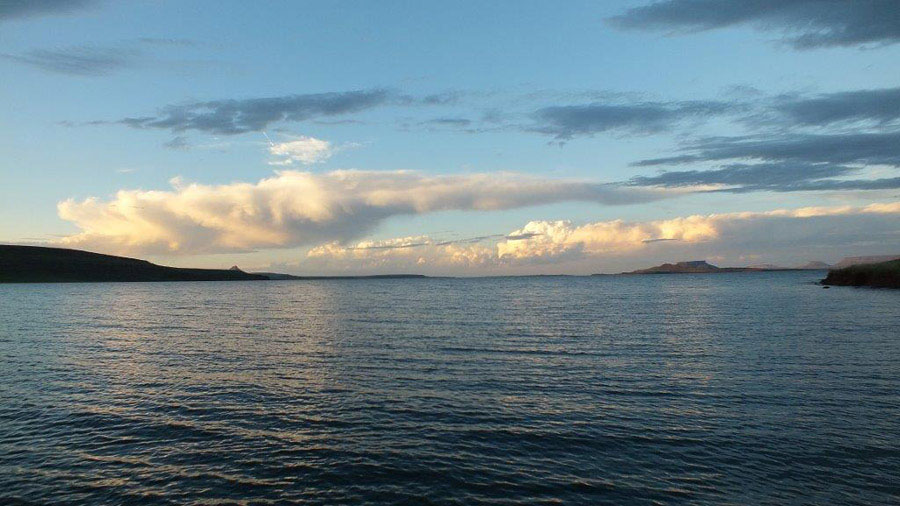
Picture by Alan Hobson
We would be fishing crystal clear water and, when fishing from the banks, if you could see the fish, there was a good chance that they had seen you first. So stealth was the key. In fact, when fishing from the edge, we would wade into the water, about waist deep, and fish towards the shore. The reason was twofold. Firstly you keep a low profile, and secondly, you would not disturb the area where eggs may have been laid.
In fact, December and January is the breeding season for small mouth yellowfish, and although the season had tailed off, there were still many pockets of fish thrashing about in their breeding process.

Picture by Alan Hobson
Some of these areas could be seen from a long way off because the banks would be wet from the spray they set up. Dave does not fish areas where breeding is taking place, as he believes that any disturbance could affect their breeding, and also because he believes that it is unethical. It was an incredible sight to see, this mass of fish thrashing about, on top of one another, bodies out of the water, right up against the banks, in the shallowest of water. So, after we had observed a few breeding shoals, they were left to do their business of multiplying in peace.

Picture by Alan Hobson
Most of the fishing was done tight up against the edges, along points where the fish would circulate, or along scum lines, close to the edge. The areas to fish were influenced by the winds which blew insects into the water. The wind varied throughout the day and on Friday afternoon we had a taste of battering our way back through a stiff westerly wind, hitting some bone jarring swells which had popped up in minutes.
So how do you fish with three anglers and a guide on a boat that is 15’6” long? When the wind permitted, all three of us fished parallel to one another, at right angles to the boat, but most times two would fish and one would sit out. When one hooked a fish, he would work the fish to the middle of the boat, on the side opposite the bank, and his place would be taken by the one who had sat out. After the fish was netted, and maybe photographed, the catcher would sit out until someone else hooked a fish, and the cycle would be repeated – worked well for me.
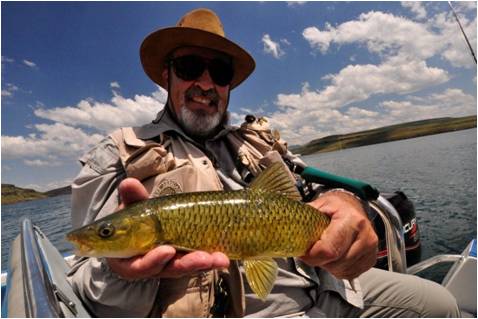
The author with a smallmouth yellowfish
Many times though, Jay opted to fish a bank or a point, and he would be dropped off, whilst Steve and I would fish from the boat. Jay said that he loves to fish from the side, and I could understand this because he was in his own little world, with this huge expanse of water and no one else around for miles.
Steve is left-handed, and a left and right handed combination on a limited space is very useful, as Dave was able to set us up on opposite ends of the boat, keeping the fly lines further apart. It still required coordination of casting, which we did fairly well, only tangling on a few occasions. Rather than waste time untangling the tippets, Dave found it quicker to cut off the fly and re-tie. He spent most of the time lying prone at the front, manning the trolling motor. He was constantly having flies whizzing past his ear, but was only hit a few times, nothing that stuck fortunately. Fortunately also, all the hooks were barbless.
Working our way back on Friday afternoon, we got to the meet the Good Doctor himself, Hans Van Zyl who was fishing from the shore. In fact his grandchildren were the ones doing the fishing, and he was supervising. I jokingly asked him what fly to use and he said that there was only one fly to fish. No need to say more. I saw some of his flies, which Jay had got from him on a previous trip, and they were perfectly tied, all looking exactly the same in the fly box. They were solid flies, lasting virtually the whole of Saturday when Jay pigged out on smallmouths which found the doctor’s purple beetle irresistible. Check out the following YouTube video to see how to tie the beetle :- https://www.youtube.com/watch?v=bbKxzvwCksI

The Good Doctor's Beetle
Although I cadged one of the purple beetles from Jay, with my lack of experience, and its dark colour, I could not follow the fly and eventually lost it when broken off. The copper beetle was easier to follow, and it was incredible to see a fish move towards the fly, mouth the fly, turn away and move off. All the time you are keeping an eye on the end of your line, any movement of which, will show that the fish has been hooked, and then tighten, and immediately let the fish run.
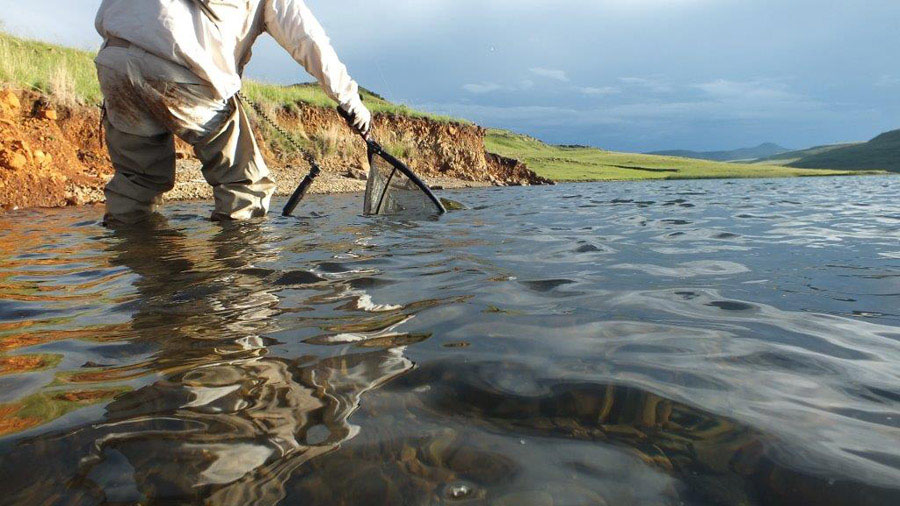
Picture by Alan Hobson
The operative word there was tighten, not striking, or setting the hook, as you have been so used to when fishing for trout or in the salt. I was told this, time and time again on Friday, when I missed so many takes when trying to set the hook. And when the fish is hooked, you allow it to take line – don’t force it, as the yellowfish has a very soft mouth and the hook can easily tear this soft flesh. Once the fish is hooked, get ready for some screaming runs into the backing. In fact my reel was the only one that laid claim to ‘screaming’ runs because it had a pawl ratchet, which was constantly getting on the other’s nerves, leading to many snarky comments. The problem was that the ratchet worked when line was pulled from the reel, and when reeling in. I opened the reel to see if I could switch off the ratchet, but it was screwed in solidly. I will certainly upgrade my reel when next I go to Sterkies, I promise chaps.
Another problem that I had was that my casting needed some adjustment. It is important to ensure that the whole line is straight, so that you are in touch with the fly at all times, because the fly would often be taken within a split second of landing. Whereas there is some benefit of having a slack leader when drifting a fly in a river, to prevent drag, slack line at Sterkies meant a missed take.
And this was my problem as many were missed. What you need to do, at the end of your forward cast, is pull back slightly on your line so that the leader will straighten and the fly will land with a slight plop. You are then instantly in touch with your fly. This is so much easier to do with a mild breeze, but it becomes exponentially more difficult with a stronger wind, and even more so when the wind is on the wrong shoulder. It became difficult to punch into the wind, aiming two or three metres to the right of your small target area, to cater for the wind, remembering to draw back on your line at its extent, and all the while balancing yourself on the rocking boat. I must admit that it became easier the longer we fished, as the casting, in all but the stronger winds, became more grooved.

Picture by Alan Hobson
Another fault, of which I was not the only guilty one is, when you make a bad cast and the fly falls a metre or two from the target, you immediately pick up the line to make a better cast, but, in doing so, the beetle makes an almighty sloooop ( can’t think of any other way to describe it). Although your corrected cast might hit the right spot it has landed on barren ground because all the fish would have been scattered by the noise. If you make a bad cast, fish it out until the fly is well away and won’t frighten the fish. In fact it is a good habit to adopt in all freshwater fishing, especially when fishing a largish dry fly. You need to start the fly moving towards you before accelerating into your backcast, and thus avoid the noise or splash.
And the flies that worked for us? For Steve and I, it was the copper beetle but for Jay it was the purple beetle. Whereas I did not vary my flies that much, I did try a DDD and a stimulator and had some good splashes but no hook-ups. I even tried a bloodworm imitation when fishing from the bank, without success. Jay rang the changes and tried almost every combination of nymphs, a klinkhamer with a chartreus post which lit up like a neon light, bloodworms and more, but really only scoring on the beetle.

Note in a previous article on this website how Alan Hobson scored with small nymphs. Picture by Alan Hobson
See http://www.tomsutcliffe.co.za/fly-fishing/friend-s-articles/item/993-micro-nymphs-and-8x-tippets-for-yellows-at-sterkies-%E2%80%93-text-and-photos-by-alan-hobson-and-al-spaeth.html
The trip was my first ever of having been guided, although at times I felt as though I was being mothered, probably the ex-teacher side of Dave showing through. I must admit that initially I got most of the attention, being a newy, and because Jay and Steve had made this trip many times before, and were generally left to their own devices, with the occasional advice when needed.
Dave has over 15 years of guiding on the water that he so obviously loves. On our trip he spent his whole time ensuring that we covered fish, that we all had an equal opportunity to catch fish, swopping positions on the boat to suit the wind direction, moving constantly to maximise the ever shifting winds, to get the best drifts. Not only was he able to serve up tips and advice on the fishing, but he also looked after our inner selves with constant supplies of cold water, iced tea, coke or surprisingly enough chocolate milk. He has excellent eyesight and was able to pick out fish which took some time to see where he was pointing. In my case he would invariably be saying, “There, there, there” and I would be saying “where, where, where?”
He also pointed out the White throated Swallow which feeds its young on the wing. We watched the young waiting on the ground, and when the parent approached, the young swallow would flutter up about a metre or so off the ground and would be fed by the adult. We saw huge carp virtually lying on top of the weed. We also got to within thirty metres or so of a jackal buzzard, roosting on a fence post.
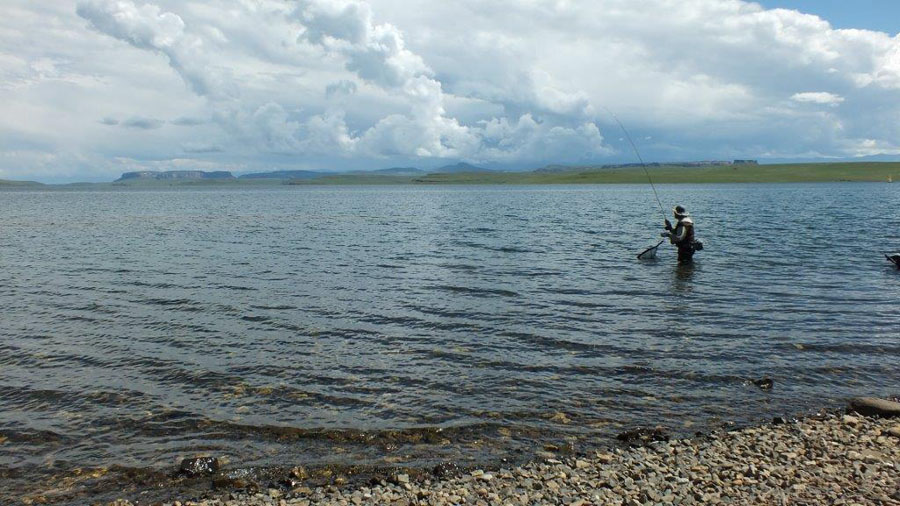
Picture by Alan Hobson
Many times we would approach a promising shore only to find other flyfishers working the area and he would not traipse on their turf, turning towards another promising area. All of the areas had names and he swore us to secrecy on the names of the hot spots. He has no fear of me revealing these areas as I can barely remember my own. The only name I do remember was The Wimpy, which we had gone to, not so much for the fishing, but for its beauty, which he wanted to share with us.
The accommodation was excellent, with us each having our own self-contained flat. Friday night we ate at the Spur because Gill was away, but on Saturday we had Dave’s signature Pesto chicken with cauliflower rice, which I can highly recommend. At Steve’s request (insistence?) we had bacon and eggs for breakfast and some excellent coffee from some beans which Jay had roasted. For lunch we helped ourselves to honey and oat bread, spread with mayonnaise (instead of butter), freshly sliced cucumber, sliced tomatoes, cheese and salami. There was also some fruit and yoghourt and even some percolated coffee. Sounds so simple, but it was a meal hard to beat, especially after thrashing the water all morning.
And who caught the most fish or the biggest fish?

One of Jay’s bank caught fish
Jay caught the greatest number of fish, especially on Saturday, which he topped with a largemouth, his first ever. In total we probably caught close to thirty yellowfish, with the biggest being 2.8 kg (mine). If you included the number of splashes, long line releases, break offs (poor knots in my case) with the number of fish caught, I think that I would have won hands down if there had been such a competition, mainly because Jay and Steve converted more of their takes into solid hook ups.
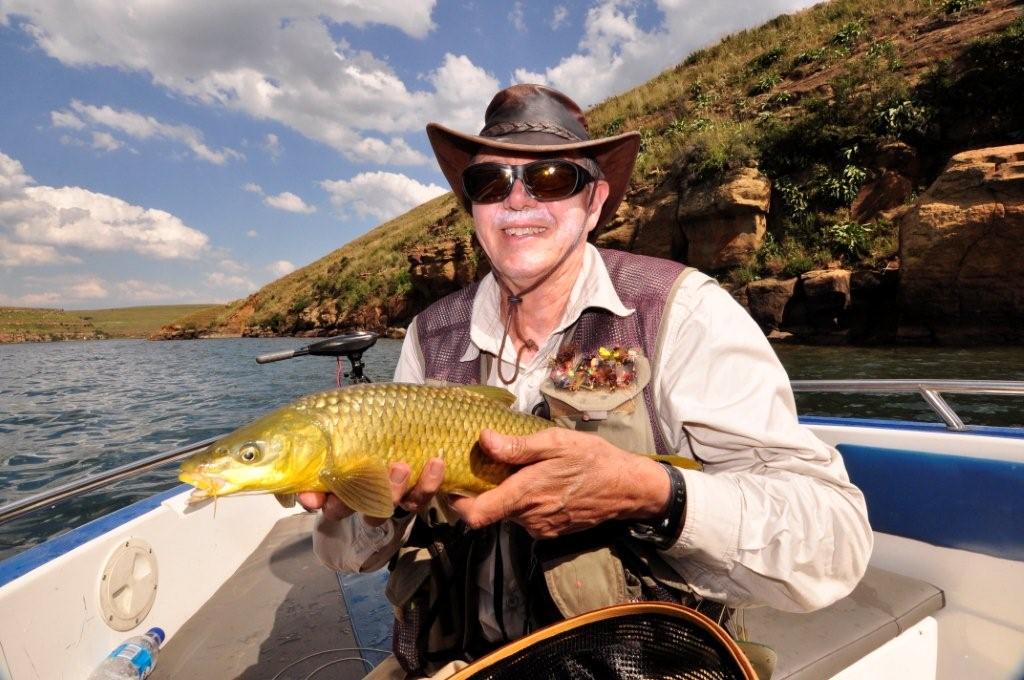
Steve with a lovely fish
I even had two decent sized bass which I managed to long-line release. When I landed my first smallmouth yellowfish, it had to be photographed, not because it was a good size, but because it was special. I got to see repeatedly why fly fishers go potty over fishing for yellowfish, because not only is it a strong and exciting fish to catch, but it is such a magnificent fish, with the most beautiful green/olive colours – which my words cannot do it justice, so hopefully the photographs will do it for me. Thanks to Dave and Jay for the pictures.
Would I go again - without a doubt? I had great company who, along with Dave, shared their knowledge so willingly, and who all made the experience so memorable for me. I am now no longer a Sterkies virgin.
(I want to thank Laurence Davies and the editors of the Bobbin, newsletter of the Durban Fly Tiers, for allowing me to reproduce this article from the March 2015 issue of their delightful newsletter. I also want to thank Alan Hobson for adding to the images from his picture bank of this great fishery. Dave Weaver is contactable at Telane Flyfishing, 0833034203 and on This email address is being protected from spambots. You need JavaScript enabled to view it.">This email address is being protected from spambots. You need JavaScript enabled to view it.. Tom Sutcliffe.)


